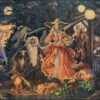Heralding Christmas With Parang
Written by: A. Felecia Valenzuela
The sweet smell of sorrel boiling, or that of hot bread fresh out the oven, or even the aromatic scent of a baked ham, immediately brings the holiday season to mind. For Caribbean people, this says Christmas is around the corner.
Regardless of what island one is from, Caribbean people, as many other nations around the world, celebrate the holiday season in their own unique way.
In Guyana for example, traditional Christmas songs can be heard playing in stores, on public transport and on the local airways.
Here in Trinidad and Tobago, music is exactly the first sign that says Christmas is approaching; with local radio stations blasting the sweet melodious tunes of “Parang”
What exactly is Parang? For those unfamiliar to this form of music; Parang is a popular folk music originating from Venezuela and Trinidad and Tobago. It was brought to the Twin Island by Venezuelan and Colombian migrants.
Those migrants were primarily of Amerindian, Spanish and Coco panyol, (cocoapanyols) of African heritage.
Some say the custom was brought over from Venezuela in the 19th century by the cocoapanyols who came from Oriente, East Venezuela to work on the cocoa plantations in Trinidad, while others say it was brought to the island by the Spanish colonists who ruled Trinidad from 1498-1797.
Whatever its origins, parang is now an integral part of the cultural landscape of Trinidad and Tobago.
The word “Parang” itself is derived from two Spanish words; parranda, meaning “a spree or fête”, and parar meaning “to stop”
During the Christmas season traditional parang music is largely performed by singers and instrumentalists collectively known as the “Parranderos”
A traditional parang group would be that of four or more men who went to give a parranda at an event; a christening or a birthday celebration. However, in Trinidad and Tobago, parang came to mean the songs that were sung especially during the Christmas season.
Groups of these “Parranderos”, now inclusive of women, would travel from house to house in the community, often joined by friends, neighbours and family, and using instruments such as the cuatro, a small, four-string guitar and maracas, locally known as chac-chacs would serenade households.
These visits involve singing and dancing as well as the sharing of food and drink.
Today, this type of social paranging takes place in towns such as; Arima, St. Anns, Santa Cruz, St. Joseph, Caura, Mausica, Lopinot, San Raphael, Rio Claro and Paramin.
The official parang season runs from October to January 6th, the Day of the Kings or Dia de los Reyes. During this period, various parang groups take part in competitions organized by the National Parang Association of Trinidad and Tobago, NPATT, culminating in Lewah (Les Rois), the feast of the Kings.
Some of the more popular parang bands are; A La Rio Suave, Lara Brothers, Los Alacranes from Paramin and Los Alumnos de San Juan among others
In the last several years Soca and Calypso have fused with parang creating Soca-Parang with lyrics in English which appeals to a more modern audience. Indian drumming and Chutney melodies have also been mixed with parang evolving into a whole new revolution of this unique style of music. Soca-Parang has also spread to other Caribbean islands like Grenada. Noted parang-soca artists include Scrunter, Baron and Ajamu.
Most Popular Posts
Caribbean Folklore With Illustration
By: Lesandra ScottSince it was way too early for bed and with her four teenage children, without any internet and evidently growing restless, Mother decided to use this inopportune moment to tell us tales and stories about entities of the night, the Caribbean folklore that she was told of when growing up as a child.
Read more ...John Legend Featuring Koffee “Don’t Walk Away”
By: David LawrenceAmerican mega pop star John legend teams up with Koffee, one of Jamaica’s current biggest dancehall artists and Grammy winner, for a super track ‘Don’t Walk Away’ on his newly released album, ‘Bigger Love’.
Read more ...Visual artist Andrea Mckenzie may now live in Atlanta, Georgia but her bold, stunning works of art remain infused with her Trinidadian roots and Caribbean culture.
“My family legacy and Carnival is my foundation. I come from a lineage of creatives”, …
Trinidad Dancehall And The Zesser Movement
By: Nekisha Cyrus‘Zesser’ a term that was initially coined and heavily associated with the Trinidad Dancehall community has now evolved into a movement. Today this movement, which was birthed within the streets of Trinidad’s ghettos is now making its way to some of the main stages, not just locally but internationally as well.
Read more ...


